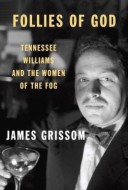Book Review: Follies of God: Tennessee Williams and the Women of the Fog
Follies of God: Tennessee Williams and the Women of the Fog
James Grissom
New York: Knopf, 2015
ISBN: 9780307265692
404 pp.
There is no question that Tennessee Williams is having a banner year. Productions of his plays continue to find appreciative audiences, John Lahr’s recently published biography of Williams masterfully reconstructs the playwright’s chaotic life, and now comes James Grissom’s Follies of God. Grissom’s extraordinary exploration of the last months of Williams’s life emphasizes the playwright’s deep desire to believe he mattered. Williams reflects on his muses—his mother, sister, and several noted actresses—all of whom provided inspiration for or the realization of his indelible characters. Revisiting his time with Williams, Grissom manages the remarkable feat of unlocking the creative process of America’s foremost dramatist, as well as of a number of actresses, at least one director, Elia Kazan, and one actor, Marlon Brando. Williams explained to Grissom that rather than critical responses to his work and late life honors, he thought “instead on those women—and a few men—who have been a constant source of inspiration and illumination; examples and extremes” (p. 17). As such, the book’s spotlight swings wildly from Williams’s waning days to his encounters with collaborators and their memories of him.
To cut to the chase, Follies of God is an absolute “must read” for those who admire Williams and his plays, love American theatre, and wish to take a highly idiosyncratic journey into the nature of creativity, the personas of its creators, and their drive to create. In the best sense this book is like no other this reader has encountered. Despite numerous prior studies of Williams’ work, Grissom’s approach provides fresh insights. The often despairing, drug-infused Williams, believing himself creatively played out in his last year, hopes – in fact, prays – to continue creating. Grissom’s encounters with Williams’s “women of the fog,” as he calls them, is accomplished through a rough chronological journey from Battle of Angels (1940) to The Night of the Iguana (1961). The actresses, consistently providing penetrating analysis of the plays and their characters, particularly those which each was associated with, comment on the work and their relationships with Williams, often with bracing honesty. Maureen Stapleton, Jessica Tandy, Kim Stanley, Julie Harris, Barbara Baxley, Katharine Hepburn, Kim Hunter, Geraldine Page, and two who did not appear in Williams’s work, but whom he found inspiring, Lillian Gish and Mildred Natwick, all provide fascinating commentary. There are tales of the conflicts in acting styles represented by those trained by Lee Strasberg or Stella Adler versus those from an older, highly theatrical approach, here represented by Katharine Cornell, Miriam Hopkins and Tallulah Bankhead; as well as reflections on changing politics and morality, including McCarthy-era blacklisting, stories of rampant homophobia, and aspects of the evolving American stage.
The book’s riches touch on art and creativity, family dysfunction, sexuality and gender, spirituality, friendship, and the ways in which the gifted struggle—some with success and some not—to harness the demons within and the brutalities of life’s experience. This handsomely bound book includes a smattering of illustrations, but the words of Williams and his muses provide insight and inspiration to those creatively inclined.
James Fisher
The University of North Carolina at Greensboro

